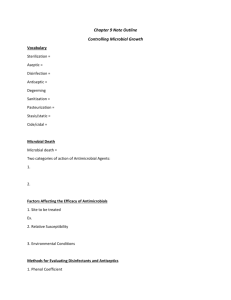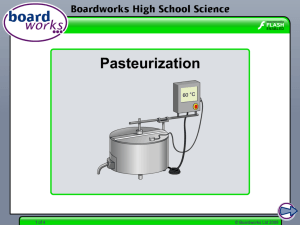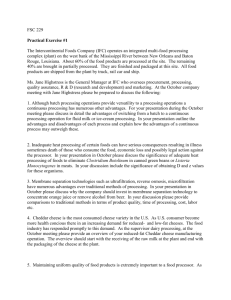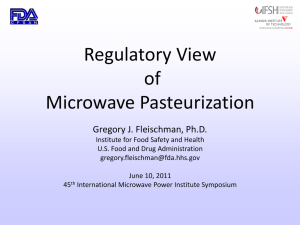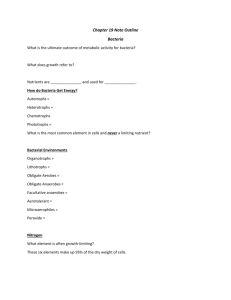Document 13359482
advertisement
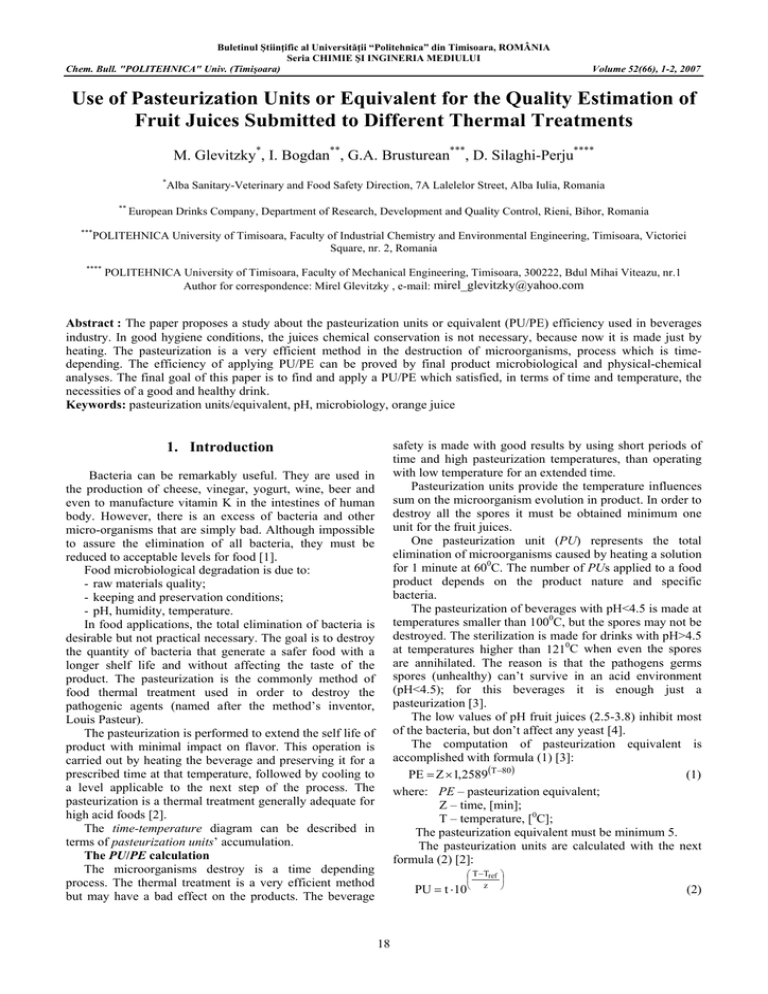
Buletinul Ştiinţific al Universităţii “Politehnica” din Timisoara, ROMÂNIA Seria CHIMIE ŞI INGINERIA MEDIULUI Chem. Bull. "POLITEHNICA" Univ. (Timişoara) Volume 52(66), 1-2, 2007 Use of Pasteurization Units or Equivalent for the Quality Estimation of Fruit Juices Submitted to Different Thermal Treatments M. Glevitzky*, I. Bogdan**, G.A. Brusturean***, D. Silaghi-Perju**** * Alba Sanitary-Veterinary and Food Safety Direction, 7A Lalelelor Street, Alba Iulia, Romania ** European Drinks Company, Department of Research, Development and Quality Control, Rieni, Bihor, Romania *** POLITEHNICA University of Timisoara, Faculty of Industrial Chemistry and Environmental Engineering, Timisoara, Victoriei Square, nr. 2, Romania **** POLITEHNICA University of Timisoara, Faculty of Mechanical Engineering, Timisoara, 300222, Bdul Mihai Viteazu, nr.1 Author for correspondence: Mirel Glevitzky , e-mail: mirel_glevitzky@yahoo.com Abstract : The paper proposes a study about the pasteurization units or equivalent (PU/PE) efficiency used in beverages industry. In good hygiene conditions, the juices chemical conservation is not necessary, because now it is made just by heating. The pasteurization is a very efficient method in the destruction of microorganisms, process which is timedepending. The efficiency of applying PU/PE can be proved by final product microbiological and physical-chemical analyses. The final goal of this paper is to find and apply a PU/PE which satisfied, in terms of time and temperature, the necessities of a good and healthy drink. Keywords: pasteurization units/equivalent, pH, microbiology, orange juice 1. Introduction safety is made with good results by using short periods of time and high pasteurization temperatures, than operating with low temperature for an extended time. Pasteurization units provide the temperature influences sum on the microorganism evolution in product. In order to destroy all the spores it must be obtained minimum one unit for the fruit juices. One pasteurization unit (PU) represents the total elimination of microorganisms caused by heating a solution for 1 minute at 600C. The number of PUs applied to a food product depends on the product nature and specific bacteria. The pasteurization of beverages with pH<4.5 is made at temperatures smaller than 1000C, but the spores may not be destroyed. The sterilization is made for drinks with pH>4.5 at temperatures higher than 1210C when even the spores are annihilated. The reason is that the pathogens germs spores (unhealthy) can’t survive in an acid environment (pH<4.5); for this beverages it is enough just a pasteurization [3]. The low values of pH fruit juices (2.5-3.8) inhibit most of the bacteria, but don’t affect any yeast [4]. The computation of pasteurization equivalent is accomplished with formula (1) [3]: PE = Z × 1,2589(T −80 ) (1) where: PE – pasteurization equivalent; Z – time, [min]; T – temperature, [0C]; The pasteurization equivalent must be minimum 5. The pasteurization units are calculated with the next formula (2) [2]: Bacteria can be remarkably useful. They are used in the production of cheese, vinegar, yogurt, wine, beer and even to manufacture vitamin K in the intestines of human body. However, there is an excess of bacteria and other micro-organisms that are simply bad. Although impossible to assure the elimination of all bacteria, they must be reduced to acceptable levels for food [1]. Food microbiological degradation is due to: - raw materials quality; - keeping and preservation conditions; - pH, humidity, temperature. In food applications, the total elimination of bacteria is desirable but not practical necessary. The goal is to destroy the quantity of bacteria that generate a safer food with a longer shelf life and without affecting the taste of the product. The pasteurization is the commonly method of food thermal treatment used in order to destroy the pathogenic agents (named after the method’s inventor, Louis Pasteur). The pasteurization is performed to extend the self life of product with minimal impact on flavor. This operation is carried out by heating the beverage and preserving it for a prescribed time at that temperature, followed by cooling to a level applicable to the next step of the process. The pasteurization is a thermal treatment generally adequate for high acid foods [2]. The time-temperature diagram can be described in terms of pasteurization units’ accumulation. The PU/PE calculation The microorganisms destroy is a time depending process. The thermal treatment is a very efficient method but may have a bad effect on the products. The beverage PU = 18 ⎛ T −Tref ⎞ ⎜ ⎟ t ⋅10⎝ z ⎠ (2) Chem. Bull. "POLITEHNICA" Univ. (Timişoara) Volume 52(66), 1-2, 2007 TABLE 2. The microbiological results of analyzed samples where: PU – pasteurization units, [min]; t – holding time, [min]; T – effective holding temperature, [0C]; Tref =60oC– reference temperature; z –temperature coefficient of microflora heat resistance, [0C]; For microorganisms commonly found in fruits, the z values are typically between 5÷7. Unfortunately, as all models, the pasteurization units have theirs limitations. A PU calculation is a figure-ofmerit and must account for the desire to decimate not only bacteria but often enzymes (which have a different z factor). Y&M/mL TVC [CFU/mL] C/mL Temp. [0C] fresh refrig. cong. fresh refrig. cong. fresh refrig. cong 200C pH Experimental, 2 liter of juice (orange juice 50% fruit) with the following characteristics were prepared: - dry substance 13 ± 0,2 0Brix; - acidity 4 ± 0,4 g/L, bottled in PET bottles. The total volume was split in tree samples. The first sample was instantly pasteurized after preparation at different temperatures (60, 70, 80, 90, 1000C) about 30 s. The others two samples were kept 24 hours at +50C and respectively at -100C, and then pasteurized in the same condition like the first sample. The samples were analyzed microbiological and the PE and PU values were computed. The pH measurement was accomplished at 250C with a pH-meter WTW pH 340i and an electrochemical cell: Electrode SenTix 81. For the same sample the measurements were repeated three times, the final result being there average. For the microbiological analysis of juice, the yeasts and moulds (Y&M) are confirmed by growth on Orangeserum Agar environment and incubation at room temperature (20-25oC), for 2-5 days, followed by their evaluation. The prove of total germs number (TVC) existence in fruit juice is based on the product insemination on plates Standard Agar, incubation at 370C during 48±2 hours and estimation of the total viable cell developed in the actual conditions (expressed as CFU/ml). The analyze of coliform bacteria (C) use Endo Agar plates, the incubation being made at 370C during 24 hours. For each treatment, the average count of plates was used to determine the coliform bacteria. 60 70 80 90 100 PE 92 30 0 0 0 3 3 87* 3 2 3 3 15* 1 0 5 5 5* 1 0 0 0 0 0 0 0 0 0 0 0 0 0 0 0 0 fresh juice 0 juice at +5 C 0 juice at -10 C 70 80 90 100 0 Figure 1. Juice pH evolution at different pasteurization temperature From the graphic representation we can notice the decrease of pH values in the same time with the increase of pasteurization temperature. Also the pH values are appropriate at 900C, temperature which is optimum for pasteurization. The comparative representation of pasteurization temperature as a function of PE for orange juice in the case of 30 seconds and 1 minute shows that the PE values grow with the temperature and are higher for 1 minute beverage pasteurization. Because it is needed that the thermal treatment don’t damage the final product we must choose high temperatures and short periods of pasteurization, for example 30 seconds at 900C when PE=5 at a juice pH of 3.726 [6]. TABLE 1. pH values of the samples and the PE/PU compute at different pasteurization temperatures refrig. 3,759 3,746 3,729 3,730 3,722 18 Pasteurization temperature [ C] The experimental data obtained as describe above, were analyzed in Table 1: Juice pH: 3 0 0 0 0 0 3.775 3.770 3.765 3.760 3.755 3.750 3.745 3.740 3.735 3.730 3.725 3.720 3.715 3.710 3.705 3.700 3.695 60 3. Results and discussion fresh 3,734 3,731 3,730 3,726 3,696 107 The analyze of microbiological experimental results shows a general decrease of microbiological population in the same time with the increasing of pasteurization temperature. We can notice an unknown microbiological growth at the pasteurization temperature of 800C, phenomenon remove by juice initial freezing followed by pasteurization. The packing in PET bottles has the following disadvantage: the bottles can’t be fill up at high temperatures. The maximum fill up temperature is 500C. The PET bottles are permeable for oxygen and can allow developing of the aerobe pathogens agents [4]. This grows, even at sub-zero water temperature is possible because in the composition of juice fruit the sugar is present. It facilitates the growing of saprophytes bacteria and also of yeasts and moulds [5]. 2. Experimental T [0C] 40 600C 0 1 700C 0 1 800C 0 1 900C 0 1 1000C 0 0 * accidental contamination PU cong. at 30 s at 1 min at 30 s at 1 min 3,769 0,005 0,010 0,5 1 3,761 0,050 0,100 13,413 26,827 3,740 0,500 1 359,843 719,686 3,731 5,000 10 9653,490 19306,980 3,725 50 100 258973,8 517947,6 19 Chem. Bull. "POLITEHNICA" Univ. (Timişoara) Volume 52(66), 1-2, 2007 qualities are damaged due to a higher pasteurization temperature. 100 90 30 s pasteurization 1 min pasteurization 80 70 4. Conclusions PE 60 The refrigeration at +50C reduces the danger of contamination but, it is not enough to guarantee the juice safety. The preservation by freezing with beverages keeping at temperatures close to -100C assures the microbiological stability and in fact extends the life of beverages comparatively with the refrigeration. The pasteurization temperature grow and the decrease of microbiological population in samples due to different kind of thermal treatments it is confirm also by the decrease of pH values. By using the pasteurization units/equivalent we can see the destroy rating of microorganisms in beverages by an empirical nonlinear dependence between pasteurization time and temperature. On the base of physico-chemical and microbiological experimental data, connected with the pasteurization units/equivalent formula, the studies allow us to establish the optimum conditions for the juice pasteurization stage in these three cases: pasteurization at 900C, during 30 s. 50 40 30 20 10 5 0 60 70 80 90 100 0 Pasteurization temperature [ C] pH Figure 2. Comparative representation of PE for different pasteurization periods 3.775 3.770 3.765 3.760 3.755 3.750 3.745 3.740 3.735 3.730 3.725 3.720 3.715 3.710 3.705 3.700 3.695 fresh juice 0 juice at +5 C 0 juice at -10 C REFERENCES 0 5 10 15 20 25 30 35 40 45 1. www.madgetech.com, Pasteurization & Sterilization Application Note, 2006. 2. www.tistr-foodprocess.net, Process Development in the Fruit and Vegetable Juice Industry III. 3. Fischer, R., Tratamentul termic, Seminar băuturi răcoritoare, Sibiu, 2006. 4. Ashurst, P.R., Chemistry and technology of soft drinks and fruit juices, Ed. Blackwell Publishing, 2005. 5. Lupea, A.X., Transformări ale biocompuşilor procesaţi în scop alimentar, Ed. CEP USM , Chişinău, 2004. 6. Tadini, C.C.; Tribess, T.B.; Silva Jr., P.A., Correlation of non linear model parameters and pH on pectinesterase termal inactivation in minimally pasteurized orange juice, International Conference Engineering and Food, ICEF9 2004. 50 PE Figure 3. pH beverages as a function of pasteurization equivalent In order to obtain a pasteurization equivalent of 5, which corresponds to a thermal treatment at a temperature and contact time proper for inactivation and destroying of microorganisms, the orange juice must achieve a pH between 3.725 and 3.732. At a lower pH value, the juice 20
